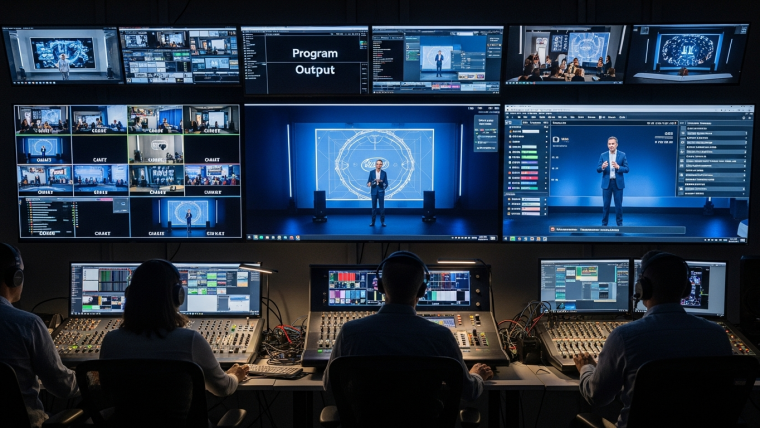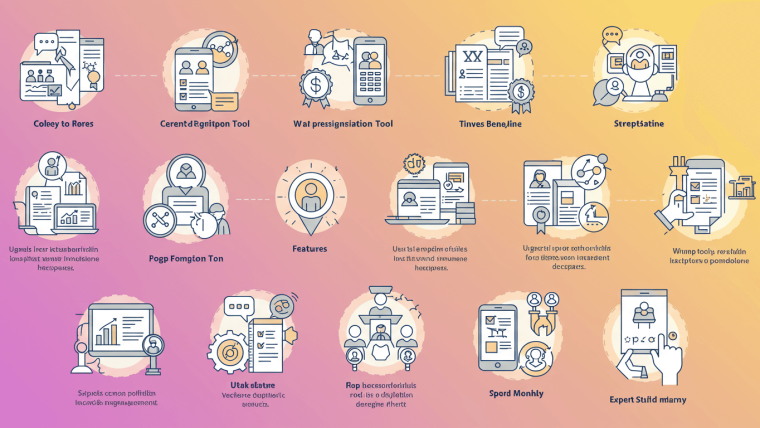Virtual events have transformed from emergency solutions to permanent fixtures in the business landscape. Yet many organizers still struggle with a persistent challenge: keeping attendees engaged when they’re sitting behind screens, surrounded by distractions, and just one click away from leaving.
The statistics paint a clear picture of this engagement crisis. While in-person events typically see attendees stay for 80-90% of the program, virtual events often experience drop-off rates exceeding 50% within the first hour. The difference lies not in the technology, but in how organizers adapt their strategies for the digital environment.
Successful virtual event engagement requires a fundamental shift in thinking. Instead of simply broadcasting content to passive viewers, effective organizers create interactive experiences that make attendees active participants. This approach transforms virtual events from one-way presentations into dynamic, memorable experiences that deliver real value.
The following strategies will help you master virtual event engagement, turning your online gatherings into experiences that attendees eagerly anticipate and actively participate in throughout.
Create Interactive Opening Moments

The first five minutes of your virtual event set the tone for everything that follows. Strong openings capture attention immediately and establish expectations for active participation.
Start with a live poll asking attendees about their goals for the event or their biggest challenges related to your topic. This technique serves multiple purposes: it gets people clicking and engaging right away, provides valuable data about your audience, and helps attendees feel heard before the content even begins.
Consider opening with a quick icebreaker that connects to your event theme. Ask attendees to share something in the chat, use reaction emojis, or participate in a brief virtual activity. These small interactions create momentum that carries throughout the event.
Welcome attendees by name as they join, especially in smaller events. This personal touch reminds people that real humans are behind the screens and creates a sense of community from the start.
Leverage Real-Time Polls and Q&A
Interactive elements keep attendees alert and engaged throughout your virtual event. Polls and Q&A sessions transform passive viewers into active participants who contribute to the conversation.
Schedule polls at strategic intervals, roughly every 10-15 minutes during presentations. Ask questions that relate directly to the content being discussed, or gather opinions on controversial topics within your industry. Share poll results immediately to maintain engagement and spark discussion.
Encourage questions throughout the presentation rather than saving them all for the end. Address questions in real-time when possible, or acknowledge them and promise to return to them later. This ongoing interaction keeps attendees mentally present and invested in the content.
Use Q&A strategically to break up longer presentation segments. A well-timed question break can re-energize your audience and provide natural transition points between topics.
Master the Art of Breakout Rooms
Breakout rooms offer one of the most powerful tools for virtual event engagement, but they require careful planning and facilitation to succeed.
Keep breakout groups small, typically 3-5 people maximum. Larger groups often result in some participants staying silent while others dominate the conversation. Smaller groups encourage everyone to participate and create more intimate discussions.
Provide clear instructions and specific discussion prompts before sending attendees to breakout rooms. Vague directions like “discuss the presentation” lead to awkward silences and unfocused conversations. Instead, give participants specific questions to answer or problems to solve.
Set definite time limits and provide warnings before bringing groups back together. Announce “you have 5 minutes remaining” to help groups wrap up their discussions naturally.
Consider appointing discussion leaders or rotating speaking roles within each breakout room to ensure balanced participation.
Gamify Your Virtual Experience
Game elements tap into natural competitive instincts and make virtual events more memorable and engaging.
Create virtual scavenger hunts that encourage attendees to pay attention to specific details throughout your presentation. Hide clues in slides, speaker comments, or resource materials, then reward participants who find them all.
Implement point systems for participation in polls, Q&A sessions, chat discussions, and other interactive elements. Display leaderboards periodically to maintain competitive interest without making non-participants feel excluded.
Design team challenges that require collaboration between attendees. These activities build connections while reinforcing your event content through practical application.
Use digital badge systems to recognize different types of participation: active chat participants, poll contributors, question askers, and networking champions.
Optimize Your Technology Setup
Technical issues destroy engagement faster than any other factor in virtual events. Smooth technology creates the foundation for meaningful interaction.
Test all technology components well before your event begins. This includes your internet connection, audio and video quality, screen sharing capabilities, and any interactive tools you plan to use.
Have backup plans ready for common technical problems. Prepare alternative communication methods, backup internet connections, and simplified versions of interactive activities that don’t rely heavily on technology.
Choose user-friendly platforms that don’t require extensive downloads or complicated setup procedures. The easier it is for attendees to join and participate, the more likely they are to stay engaged throughout your event.
Provide clear technical instructions and support resources before the event begins. Include these in confirmation emails and display them prominently as attendees join.
Design Multi-Sensory Experiences
Virtual events often rely too heavily on visual and auditory elements while ignoring other ways to create memorable experiences.
Send physical materials to attendees before the event. This might include workbooks, branded items, samples, or materials for hands-on activities. Physical elements create stronger memory connections and give attendees something tangible to associate with your event.
Incorporate movement and physical activities when appropriate. Ask attendees to stand up, stretch, or complete simple exercises that relate to your content. These breaks combat “screen fatigue” while maintaining engagement.
Use varied presentation formats throughout your event. Mix traditional presentations with demonstrations, interviews, panel discussions, and interactive workshops to keep the experience fresh and dynamic.
Encourage attendees to engage multiple senses by taking notes by hand, creating visual mind maps, or participating in tactile activities related to your content.
Build Community Through Chat Management
The chat function serves as the social heartbeat of virtual events, but it requires active management to reach its full potential.
Assign dedicated chat moderators who can respond to questions, encourage participation, and maintain positive energy throughout the event. Moderators should actively engage with attendees rather than simply monitoring for problems.
Create chat etiquette guidelines that encourage participation while maintaining professionalism. Share these guidelines at the beginning of your event and reinforce them gently when necessary.
Use chat for more than just Q&A. Encourage attendees to share relevant experiences, resources, and insights that add value for other participants. This peer-to-peer interaction often proves more valuable than formal presentations.
Acknowledge and respond to chat contributions regularly. When attendees see their comments being recognized, they’re more likely to continue participating throughout the event.
Implement Strategic Content Breaks
Attention spans are shorter in virtual environments, making strategic breaks essential for maintaining engagement throughout longer events.
Schedule breaks every 45-60 minutes during extended virtual events. Even short 5-10 minute breaks allow attendees to rest their eyes, move around, and return refreshed for the next session.
Use “brain breaks” that involve quick, engaging activities related to your content. These might include brief meditation exercises, quick polls about upcoming topics, or simple physical movements that energize participants.
Create networking breaks specifically designed for virtual environments. Use breakout rooms, structured networking activities, or guided discussion prompts that help attendees make meaningful connections.
Consider implementing “choice breaks” where attendees can select from multiple brief activities: networking, Q&A with speakers, resource exploration, or simply taking personal time.
Personalize the Virtual Experience
Personalization helps attendees feel valued and increases their investment in your virtual event.
Use attendee registration data to customize content and interactions. Reference specific industries, job roles, or interests represented in your audience when providing examples or case studies.
Create multiple content tracks or breakout sessions that cater to different experience levels, interests, or goals. Allow attendees to choose their own adventure within your event structure.
Follow up personally with active participants during and after the event. Acknowledge their contributions, answer their specific questions, and provide additional resources tailored to their interests.
Use attendee names frequently throughout the event. Thank specific individuals for their questions, comments, and participation to create personal connections even in large virtual gatherings.
Encourage Peer-to-Peer Learning
Some of the most valuable learning happens between attendees rather than from official speakers or content.
Design activities that require attendees to share their own experiences and expertise. This might include case study discussions, problem-solving sessions, or skill-sharing workshops.
Create virtual networking opportunities that go beyond simple introductions. Use structured networking formats that give attendees specific conversation starters and goals.
Establish peer mentoring connections during your event. Match experienced attendees with newcomers or create small groups with complementary skills and interests.
Use collaborative tools that allow attendees to contribute to shared documents, brainstorming sessions, or resource collections that benefit the entire group.
Maintain Energy and Momentum
Virtual events require more intentional energy management than in-person gatherings where natural group dynamics help maintain momentum.
Vary your pacing throughout the event. Alternate between high-energy interactive segments and more reflective, content-heavy portions to create natural rhythms that keep attendees engaged.
Use music, sound effects, and visual elements strategically to maintain energy and signal transitions between activities. These audio and visual cues help replace the natural energy shifts that occur in physical spaces.
Monitor attendee engagement actively throughout your event. Watch for declining chat participation, lower poll response rates, or other signs that energy is flagging, then adjust your approach accordingly.
Build excitement for upcoming segments by previewing interesting content, special guests, or valuable resources that attendees won’t want to miss.
Follow Up for Lasting Impact

Engagement shouldn’t end when your virtual event concludes. Effective follow-up strategies extend the value and maintain connections formed during your event.
Send personalized thank-you messages that reference specific contributions or questions from individual attendees. This personal touch reinforces the value of their participation and encourages future engagement.
Provide comprehensive event resources including recordings, slides, additional materials, and answers to questions that weren’t addressed during the live event.
Create ongoing community spaces where attendees can continue conversations, share resources, and maintain connections formed during your virtual event.
Survey attendees about their experience and use their feedback to improve future virtual events. Show that you value their input by implementing suggested improvements and acknowledging their contributions.
Transform Your Virtual Events Into Engaging Experiences
Virtual event engagement requires intentional strategy, careful planning, and ongoing attention to participant needs. The most successful virtual events create active, participatory experiences that rival the engagement levels of in-person gatherings.
Start implementing these strategies one at a time rather than trying to incorporate everything at once. Choose the techniques that align best with your audience, content, and event goals, then build your virtual event engagement skills gradually through practice and refinement.
Remember that virtual event engagement is an ongoing process, not a one-time achievement. Continuously gather feedback, monitor participation levels, and adapt your approach based on what works best for your specific audience and event format.








Webinar Analytics: A Complete Guide to Measuring Success and Improving Performance
The Ultimate Webinar Follow-Up Strategy to Turn Attendees into Customers
Webinar Accessibility Best Practices: How to Make Your Online Events Inclusive for All
Webinar Personalization: Tailoring Content to Audience Segments for Maximum Engagement